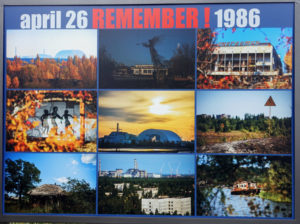On the television today was coverage of the 50th anniversary of the Aberfan disaster. I remember reading about this in the Evening Standard while on the tube in London on the evening it happened. In those days you didn’t know about things instantly by twitter and it was breaking news in the early evening. It got me thinking about whether I would ever view the village as a tourist site and of course I wouldn’t. However I did want to go to Chernobyl, the site of a disaster on an even greater scale.
I’m not really sure why . We’ve been to Pompeii, a disaster site but distanced by the length of time since it happened. We’ve been to Auschwitz which can be viewed as a history lesson and we’ve been to Hiroshima an exercise in how to promote peace from something unspeakably awful. But we chose not to go on a tour about hurricane Katrina in New Orleans as it seemed distasteful. So why make the considerable effort to go to Chernobyl? This is another disaster that I can remember first hearing about on the news, this time the TV. Living in Lancashire at the time I can recollect talk of the local sheep becoming radioactive. So to see what the effects really were was a factor. Also anyone who has an interest in travel photography wants to recreate the iconic fairground pictures of the abandoned town of Pripyat.
We were told that radiation levels were completely safe as long as we had closed toe shoes, didn’t eat outside and did not stray from the paths or unnecessarily touch things. We should receive less radiation than on a trans Atlantic flight. At our age this is not really a long term concern. If I had been in my twenties I might have decided it was not worth taking the risk (actually that’s a lie at twenty I took all sorts of risks I wouldn’t consider now!)
Walking around Chernobyl
Ukraine was part of Russia on 26th April 1986 when an explosion released radioactive contamination into the atmosphere. The worst nuclear power plant accident ever. The exclusion zone was set up to restrict access reducing the spread of contamination. It is still the most contaminated area on earth but the zone was opened to tourists in 2002.
The new safe confinement arch is designed to contain radiation for the next one hundred years. It will be finished next year.
The Pictures Everybody Takes
The Russian Woodpecker
The Russian Woodpecker, named by American radio operators because of its relentless tapping, or the Duga-3 ballistic missile defence radar.
This officially didn’t exist and was disguised as a children’s summer camp deep in the woods not far from the power plant.






















